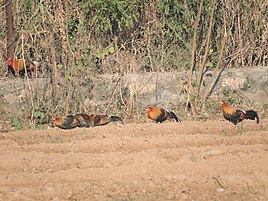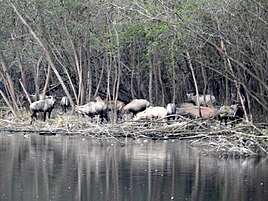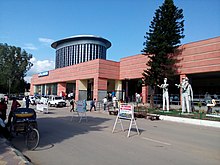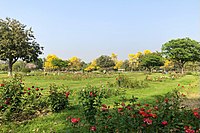Chandigar
Chandigarh is one of the earliest planned cities in post independence India and is internationally known for its architecture and urban design. The master plan of the city was prepared by Swiss-French architect Le Corbusier, which built upon earlier plans created by the Polish architect Maciej Nowicki and the American planner Albert Mayer. Most of the government buildings and housing in the city were designed by a team headed by Le Corbusier, Jane Drew and Maxwell Fry. Chandigarh's Capitol Complex—as part of a global ensemble of Corbusier's buildings—was declared a World Heritage Site by UNESCO at the 40th session of the World Heritage Conference in July 2016.
Chandigarh has grown greatly since its initial construction, and has also driven the development of Mohali and Panchkula; the "tri-city" metropolitan area has a combined population of over 1,611,770. The city has one of the highest per capita incomes in the country. The union territory has one of the highest Human Development Index among Indian states and territories. In 2015, a survey by LG Electronics ranked it as the happiest city in India on the happiness index. In 2015, an article published by BBC named Chandigarh one of the few master-planned cities in the world to have succeeded in terms of combining monumental architecture, cultural growth, and modernisation.
Etymology
The name Chandigarh is a compound of Chandi and Garh. Chandi refers to the Hindu goddess Chandi and Garh means fortress. The name is derived from Chandi Mandir, an ancient temple devoted to Chandi near the city in Panchkula District.
The motif or sobriquet of "The City of Beauty" was derived from the City Beautiful movement, which was a popular philosophy in North American urban planning during the 1890s and 1900s. Architect Albert Mayer, the initial planner of Chandigarh, lamented the American rejection of City Beautiful concepts and declared, "We want to create a beautiful city..." The phrase was used as a logo in official publications in the 1970s and is now how the city describes itself.
History
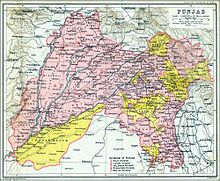


Some Indus Valley artefacts have been discovered on the site of Chandigarh, suggesting that the area was home to some settlements of the Indus Valley civilisation. Present-day Chandigarh was also the site of a short-lived late 18th-century principality, with a small fort at Mani Majra. Many villages that predate the city are still inhabited within the modern blocks of some sectors, including Burail and Attawa, while several other such villages lie on the margins of the city.
As part of the partition of India in 1947, the former Indian province of Punjab was divided into two parts, the mostly Hindu and Sikh East Punjab in India, and the mostly Muslim West Punjab in Pakistan. The capital of undivided Punjab, Lahore, had become part of Pakistan after the partition. Instead of shifting the capital to an already existing and established city, Jawaharlal Nehru, the first Prime Minister of India, envisioned an altogether new and modern city to be built to serve as the capital of Punjab. Partap Singh Kairon, then the Chief Minister of East Punjab, and Edward Nirmal Mangat Rai, then the Chief Secretary of East Punjab, were instrumental in creating Chandigarh as the capital of the state.
In 1949, the American planner and architect Albert Mayer was commissioned to design a new city to be called "Chandigarh". The government carved out Chandigarh from about fifty Puadhi-speaking villages in the then-state of East Punjab, India. Shimla was the temporary capital of the state until Chandigarh was completed. Albert Mayer developed a superblock-based city interspersed with green spaces, with an emphasis on cellular neighbourhoods and traffic segregation. His site plan took advantage of natural land characteristics; the land's gentle grade promoted proper drainage. Mayer stopped his work on the city after his architect-partner Matthew Nowicki died in a plane crash in 1950. Government officials recruited Le Corbusier to succeed Mayer and Nowicki, who utilised many elements of Mayer's original plan without attributing them to him. Le Corbusier designed many administration buildings, including the High Court, the Palace of Assembly, and the Secretariat Building. Le Corbusier also designed the general layout of the city, dividing it into sectors. Chandigarh hosts the largest of Le Corbusier's many Open Hand sculptures, standing 26 metres high. The Open Hand (La Main Ouverte) is a recurring motif in Le Corbusier's architecture, a sign for him of "peace and reconciliation. It is open to give and open to receive." It represents what Le Corbusier called the "Second Machine Age". Two of the six monuments planned in the Capitol Complex which has the High Court, the Assembly, and the Secretariat, remain incomplete. These include Geometric Hill and Martyrs Memorial. Drawings were made, and they were begun in 1956, but they were never completed.
The capital city was officially shifted from Shimla to Chandigarh on 21 September 1953, though Chandigarh was formally inaugurated by India's first president, Rajendra Prasad on 7 October 1953.
On 1 November 1966, after a long-drawn movement demanding the formation of a Punjabi state, the former state of Punjab was split in two. The western and northern mostly Punjabi-speaking portion became the present-day state of Punjab, while the eastern and southern Hindi- and Haryanvi-speaking areas became Haryana. Chandigarh ended up being located on the border of the two states, and both of them moved to incorporate the city into their respective territories. However, the city of Chandigarh was controlled directly by the central government and was to serve as the shared capital of the two states until a resolution could be reached. It has been claimed by industrialists that large real-estate projects have stagnated since the creation of Chandigarh in Punjab and Haryana as an economic rival city would be perceived as a city that could be used as capital instead of Chandigarh and hence relinquishing the state of rights over Chandigarh.
Geography

Location
Chandigarh is located by the foothills of the Shivalik Range of the Himalayas in northwest India. It covers an area of approximately 114 km. It borders the states of Punjab and Haryana. The exact geographic coordinates of Chandigarh are 30°44′N 76°47′E / 30.74°N 76.79°E. It has an average elevation of 321 metres (1053 ft).
The city, lying in the northern plains, includes a vast area of flat, fertile land. Its northeast covers sections of Bhabar, while the remainder of its terrain is part of the Terai. Its surrounding cities are Mohali, New Chandigarh, Patiala, Zirakpur and Rupnagar in Punjab, and Panchkula and Ambala in Haryana.
Chandigarh is situated 44 km (28 miles) north of Ambala, 229 km (143 miles) southeast of Amritsar, and 250 km (156 miles) north of Delhi.
Climate

Chandigarh has a humid subtropical climate (Köppen: Cwa) characterised by a seasonal rhythm: very hot summers, mild winters, unreliable rainfall, and great temperature variation (−1 to 45 °C or 30.2 to 113.0 °F). The average annual rainfall is 1,110.7 millimetres or 43.73 inches. The city also receives occasional winter rains from the Western Disturbance originating over the Mediterranean Sea. The western disturbances bring rain predominantly from mid-December until the end of April, which can be heavier sometimes with strong wind and hail if the weather turns colder (during March–April months), which usually proves disastrous to local crops. Cold winds usually tend to come from the Himalayas that lie to the north, which receive snowfall during wintertime.
The city experiences the following seasons and the respective average temperatures:
- Spring: During spring (from February-end to mid-April), temperatures vary between a maximum of 13 to 20 °C or 55.4 to 68.0 °F and a minimum of 5 to 12 °C or 41.0 to 53.6 °F.
- Autumn: In autumn (from September-end to mid-November), the temperature may rise to a maximum of 30 °C or 86 °F. Temperatures usually remain between 10 and 22 °C or 50.0 and 71.6 °F in autumn. The minimum temperature is around 6 °C or 42.8 °F.
- Summer: The temperature in summer (from mid-April to mid-June) usually peaks at around 43 °C or 109.4 °F in mid-June, and generally varies between 38 and 42 °C (100.4 and 107.6 °F).
- Monsoon: During the monsoon season (from mid-June to mid-September), Chandigarh receives moderate to heavy rainfall and sometimes heavy to very heavy rainfall (generally during August or September). Usually, the rain-bearing monsoon winds blow from the southwest/southeast. The city mostly receives heavy rain from the south (which is mainly persistent rain), but it generally receives most of its rain during the monsoon season either from the northwest or the northeast. The maximum amount of rain received by the city of Chandigarh during the monsoon season is 195.5 millimetres or 7.70 inches in a single day.
- Winter: Winters (November-end to February-end) are mild but can get chilly during peak winter weeks. Average temperatures in the winter generally fluctuate between a maximum of 5 to 14 °C or 41.0 to 57.2 °F and a minimum of −1 to 5 °C or 30.2 to 41.0 °F. Rain usually comes from the west during winter, and it rains for 2–3 days, sometimes with hailstorms.
| Month | Jan | Feb | Mar | Apr | May | Jun | Jul | Aug | Sep | Oct | Nov | Dec | Year |
|---|---|---|---|---|---|---|---|---|---|---|---|---|---|
| Record high °C (°F) | 27.7 (81.9) |
32.8 (91.0) |
37.8 (100.0) |
43.3 (109.9) |
46.0 (114.8) |
45.3 (113.5) |
42.0 (107.6) |
39.0 (102.2) |
37.5 (99.5) |
37.0 (98.6) |
34.0 (93.2) |
28.5 (83.3) |
46.0 (114.8) |
| Mean daily maximum °C (°F) | 18.2 (64.8) |
22.6 (72.7) |
28.0 (82.4) |
34.6 (94.3) |
38.6 (101.5) |
37.7 (99.9) |
34.1 (93.4) |
33.2 (91.8) |
32.9 (91.2) |
32.0 (89.6) |
27.0 (80.6) |
22.1 (71.8) |
29.9 (85.8) |
| Mean daily minimum °C (°F) | 7.2 (45.0) |
10.4 (50.7) |
14.7 (58.5) |
20.3 (68.5) |
24.7 (76.5) |
26.7 (80.1) |
26.9 (80.4) |
26.2 (79.2) |
24.4 (75.9) |
18.4 (65.1) |
12.3 (54.1) |
8.0 (46.4) |
18.2 (64.8) |
| Record low °C (°F) | 0.0 (32.0) |
0.0 (32.0) |
4.2 (39.6) |
7.8 (46.0) |
13.4 (56.1) |
14.8 (58.6) |
14.2 (57.6) |
17.2 (63.0) |
14.3 (57.7) |
9.4 (48.9) |
3.7 (38.7) |
0.0 (32.0) |
0.0 (32.0) |
| Average rainfall mm (inches) | 37.8 (1.49) |
37.3 (1.47) |
27.4 (1.08) |
17.5 (0.69) |
26.8 (1.06) |
146.7 (5.78) |
275.6 (10.85) |
273.0 (10.75) |
154.6 (6.09) |
14.2 (0.56) |
5.2 (0.20) |
22.3 (0.88) |
1,038.4 (40.88) |
| Average rainy days | 2.3 | 3.0 | 2.2 | 1.9 | 2.2 | 6.5 | 9.8 | 11.1 | 6.0 | 0.8 | 0.5 | 1.3 | 47.5 |
| Average relative humidity (%) (at 17:30 IST) | 47 | 42 | 34 | 23 | 23 | 39 | 62 | 70 | 59 | 40 | 40 | 46 | 44 |
| Source: India Meteorological Department
| |||||||||||||
Chandigarh has been ranked 27th best "National Clean Air City" (under Category 1 >10L Population cities) in India.
Wildlife and biodiversity
Most of Chandigarh is covered by dense banyan and eucalyptus plantations. Ashoka, cassia, mulberry and other trees flourish in the forested ecosystem. The city is surrounded by forests that sustain many animal and plant species. Deer, sambars, barking deer, parrots, woodpeckers, and peacocks inhabit the protected forests. Sukhna Lake hosts a variety of ducks and geese and attracts migratory birds from parts of Siberia and Japan in the winter season. The Parrot Bird Sanctuary Chandigarh provides a home to a large number of parrots. Sukhna Wildlife Sanctuary was declared a wildlife sanctuary in 1998.
-
Junglefowl, Sukhna wildlife sanctuary, Chandigarh
-
Sambar deer in City Forest Park, Chandigarh
-
Parakeets at the Parrot Bird Sanctuary
-
Nilgai, Dhanas lake, Chandigarh
Heritage Trees of Chandigarh

Many trees in Chandigarh are given the status of the natural heritage of the city. The Chandigarh government has identified a list of 31 trees as Heritage Trees. The Department of Forest & Wildlife Chandigarh Administration is the nodal department for this purpose and has published a detailed booklet about it. The trees in the city that are a hundred or more years old have been given heritage status.
Landscape
Sukhna Lake, a 3 km artificial rain-fed lake in Sector 1, was created in 1958 by damming the Sukhna Choe, a seasonal stream coming down from the Shivalik Hills.
Chandigarh has a belt of parks running from sectors. It is known for its green belts and other special tourist parks. Sukhna Lake itself hosts the Garden of Silence. The Rock Garden, is located near the Sukhna Lake and has numerous sculptures made by using a variety of different discarded waste materials. The Zakir Hussain Rose Garden (which is also Asia's largest rose garden) contains nearly 825 varieties of roses in it and more than 32,500 varieties of other medicinal plants and trees. Other gardens include the Garden of Fragrance in Sector 36, Garden of Palms in Sector 42, Butterfly Park in Sector 26, Valley of Animals in Sector 49, the Japanese Garden in Sector 31, the Terraced Garden in Sector 33, Shanti Kunj Garden, the Botanical garden and the Bougainvillea Garden. There is also the Government Museum and Art Gallery, Chandigarh in Sector 10.
Demographics
| Year | Pop. | ±% p.a. |
|---|---|---|
| 1901 | 21,967 | — |
| 1911 | 18,437 | −1.74% |
| 1921 | 18,133 | −0.17% |
| 1931 | 19,783 | +0.87% |
| 1941 | 22,574 | +1.33% |
| 1951 | 24,261 | +0.72% |
| 1961 | 119,881 | +17.32% |
| 1971 | 257,251 | +7.93% |
| 1981 | 451,610 | +5.79% |
| 1991 | 642,015 | +3.58% |
| 2001 | 900,635 | +3.44% |
| 2011 | 1,055,450 | +1.60% |
| source: | ||
Population

As of 2011 India census, Chandigarh had a population of 1,055,450, giving it a density of about 9,252 (7,900 in 2001) persons per square kilometre.
Males constitute 55% of the population and females 45%. The sex ratio is 818 females for every 1,000 males. The child-sex ratio is 880 females per thousand males. Chandigarh has an effective literacy rate of 86.77% (based on population 7 years and above), higher than the national average; with male literacy of 90.81% and female literacy of 81.88%. 10.8% of the population is under 6 years of age. The population of Chandigarh formed 0.09 per cent of India in 2011.
There has been a substantial decline in the population growth rate in Chandigarh, with just 17.10% growth between 2001 and 2011. Since the 1951–1961 period, the growth rate has decreased from 394.13% to 17.10%, a likely cause being the rapid urbanisation and development in neighbouring cities. The urban population constitutes 97.25% of the total and the rural population makes up 2.75%, as there are only a few villages within Chandigarh, situated on its Western and South-Eastern border, and the majority of people live in the heart of Chandigarh.
Languages
English is the sole official language of Chandigarh. The majority of the population speaks Hindi (67.76%) while Punjabi is spoken by 22.02%. Government schools use English, Hindi, and Punjabi textbooks. The percentage of Punjabi speakers has fallen from 36% in 1981 to 22% in 2011, while that of Hindi speakers has increased from 51% to 78%.
Religion
Hinduism is the predominant religion of Chandigarh followed by 80.71% of the population. Sikhism is the second most followed religion in the city, followed by 13.11% of the people, followed by Islam at 4.87%. Minorities are Christians at 0.83%, Jains at 0.19%, Buddhists at 0.11%, those that didn't state a religion at 0.10%, and others are 0.02%.
There are several places of worship located all over the city, with many in each sector, including the historic Mata Basanti Devi Mandir in Sector 24. The temple is dedicated to Goddess Shitala and specially visited by devotees during first Tuesday of Chaitra month after Holi. Chandi Mandir, Mata Mansa Devi Mandir and Mata Jayanti Devi Mandir are important Hindu temples located near Chandigarh.Nada Sahib Gurudwara, a famous place for Sikh worship lies in its vicinity. Apart from this, there are a couple of historical mosques in Manimajra and Burail. The Diocese of Simla and Chandigarh serves the Catholics of the city, with a co-cathedral in the city, which also governs most of the convent schools in Chandigarh.
Health
The table below shows the data from the district nutrition profile of children below the age of 5 years, in Chandigarh, as of year 2020.
| Indicators | Number of children (<5 years) | Percent (2020) | Percent (2016) |
|---|---|---|---|
| Stunted | 23,133 | 25% | 29% |
| Wasted | 7,690 | 8% | 11% |
| Severely wasted | 2,140 | 2% | 4% |
| Underweight | 18,799 | 21% | 24% |
| Overweight/obesity | 1,692 | 2% | 1% |
| Anemia | 44,830 | 55% | 73% |
| Total children | 91,436 |
The table below shows the district nutrition profile of women in Chandigarh between the ages of 15 and 49 years, as of the year 2020.
| Indicators | Number of women (15–49 years) | Percent (2020) | Percent (2016) |
|---|---|---|---|
| Underweight (BMI <18.5 kg/m^2) | 57,268 | 13% | 13% |
| Overweight/obesity | 193,769 | 44% | 41% |
| Hypertension | 110,178 | 25% | 12% |
| Diabetes | 83,415 | 29% | NA |
| Anemia (non-preg) | 264,506 | 60% | 76% |
| Total women (preg) | 37,116 | ||
| Total women | 440,183 |
Government and politics

Administrator of the Union Territory
Article 239 of the Constitution of India provides for the administration of the Union Territories by the President through an administrator. Since 1984 the Governor of Punjab has served concurrently as the administrator of Chandigarh. Gulab Chand Kataria has been the administrator of the union territory since 27 July 2024.
Politics
Chandigarh, as a union territory, is not entitled to a state-level election: thus State Assembly elections are not held and it is directly controlled by the central government. One seat for Chandigarh is allocated in the Lok Sabha elections held every five years.
Manish Tewari (INC) is the Member of Parliament elected in 2024 from the Chandigarh Lok Sabha constituency.
Civic administration
The city is governed by a civic administration or local government headed by Municipal Commissioner Amit Kumar and Mayor Harpreet Kaur Babla. The city comprises 35 wards represented by 35 elected councillors, and also nominates 9 councillors.
On 27 March 2022, Union Home Minister Amit Shah announced that the Chandigarh employees who were working under the Punjab service rules until 2022, would be working under the central civil services rules from 1 April 2022. The move was criticised by political parties such as the AAP, the INC and the Akali Dal.
Composition of Chandigarh Municipal Corporation after 2021 Chandigarh Municipal Corporation election as of December 2021:
| Party | Seats | Seats +/− | |
|---|---|---|---|
| Aam Aadmi Party | 14 | ||
| Bharatiya Janata Party | 14 | ||
| Indian National Congress | 6 | ||
| Shiromani Akali Dal | 1 | ||
| Nominated | 9 | ||
| Member of Parliament | 1 | ||
Civic utilities
The prime responsibilities of the civic body Municipal Corporation Chandigarh, are to ensure cleanliness and sanitation in the city, illumination of street lights, maintenance of parks, and sewerage disposal. The city has both brick and pipe sewers laid in four phases. In September 2020, the civic body announced that it would upgrade and renew the 50-year-old sewerage system. The pilot project for the 24x7 water supply is expected to begin in Chandigarh in May 2021, which was initially to start in September 2020 and end in March 2022. On 8 April 2021, the Chandigarh Smart City Ltd (CSCL) board is yet to take the final decision.
In 2021, the BJP-ruled corporation had increased the water tariff by 1.5 to 2.5 times. This created a widespread discontent among the residents.
In 2021, there was an acute shortage of parking spaces. The problem was aggravated by an increase of 17% in parking rates by the Municipal Corporation. The increase in the waste collection charges, water tariff and property tax rates during the last five years 2016 to 2021 were unpopular among the public.
During the COVID-19 pandemic in India, concerns were raised about whether sufficient relief measures had been taken by the local government. The sitting Councillors were accused of not being found to be approachable when the public needed support.
Cleanliness
In 2016, Chandigarh was the second cleanest city of India.
In 2021, Chandigarh fell 66 positions in the list of cleanest cities in India. The garbage piled up at the Dadu Majra garbage dump site. The city's cleanliness was once a point for the city, and its decline became an important poll issue.
Economy
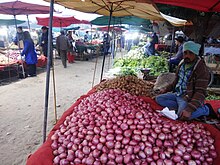
Chandigarh has been rated as one of the "Wealthiest Towns" of India. The Reserve Bank of India ranked Chandigarh as the third-largest deposit centre and seventh-largest credit centre nationwide as of June 2012. With an average household monthly income of ₹199,000 (US$2,300), Chandigarh is one of the richest towns in India. Chandigarh's gross state domestic product for 2014–15 is estimated at ₹290 billion (equivalent to ₹440 billion or US$5.1 billion in 2023) at current prices. According to a 2014 survey, Chandigarh is ranked 4th in the top 50 cities identified globally as "emerging outsourcing and IT services destinations" ahead of cities like Beldon (Amritsar).
The Rajiv Gandhi Chandigarh Technology Park, also known as the Chandigarh IT Park, is a special economic zone which has facilities for information technology.
Technology Park, which has changed the economic scenario of the city and the vicinity by facilitating the growth of the economy, especially in the Services sector.
Employment
The government is a major employer in Chandigarh, with three governments having their base here, those being the Chandigarh Administration, the Punjab government, and the Haryana government. A significant percentage of Chandigarh's population, therefore, consists of people who are either working for one of these governments or have retired from government service, mainly armed forces. For this reason, Chandigarh is often called a "Pensioner's Paradise". Ordnance Cable Factory of the Ordnance Factories Board has been set up by the Government of India. There are about 15 medium-to-large industries, including two in the public sector. In addition, Chandigarh has over 2,500 units registered under the small-scale sector. The city's important industries are paper manufacturing, basic metals and alloys, and machinery. Other industries in the city are food products, sanitary ware, auto parts, machine tools, pharmaceuticals, and electrical appliances.
The main occupation here is trade and business. However, the Punjab and Haryana High Court, Post Graduate Institute of Medical Education and Research (PGIMER), the availability of an IT Park, and more than a hundred government schools provide other job opportunities to people.
Four major trade promotion organisations have their offices in Chandigarh. These are The Associated Chambers of Commerce & Industry, ASSOCHAM India, Federation of Indian Chambers of Commerce & Industry, (FICCI) the PhD Chamber of Commerce and Industry and the Confederation of Indian Industry (CII) having regional offices in Chandigarh.
Chandigarh IT Park (also known as Rajiv Gandhi Chandigarh Technology Park) is the city's attempt to break into the information technology world. Chandigarh's infrastructure, proximity to Delhi, Haryana, Punjab, and Himachal Pradesh, and the IT talent pool attract IT businesses looking for office space in the area. Major Indian firms and multinational corporations like Quark, Infosys, EVRY, TechMahindra, Airtel, Amadeus IT Group, DLF have set up base in the city and its suburbs.
The work of the Chandigarh Metro was slated to start by 2019. It was opposed by the Member of Parliament from Chandigarh, Kirron Kher. With an estimated cost of around ₹109 billion including 50% funds from the governments of Punjab and Haryana and 25% from Chandigarh and government of India, funds from the Japanese government were proposed to include approximately 56% of the cost. However, the project was turned down owing to its non-feasibility. Kher promised a film city for Chandigarh. After winning the seat, she said that she had difficulty in acquiring land in Chandigarh. Her proposal was accepted by the Chandigarh Administration and the film city is proposed to be set up in Sarangpur, Chandigarh. This has been considered as a source of employment in the future.
Culture

Festivals
Every year, in September or October during the festival of Navratri, many associations and organisations hold a Ramlila event, which has been conducted here for over 50 years.
The Rose Festival in Zakir Hussain Rose Garden every February shows thousands of subspecies of roses.
Chandigarh Carnival is an annual mega tourism event of Chandigarh Administration which is held in the last week of November every year.As a part of event, the department organises various fun and flora activities including setting up of amusement park, stalls, day cultural programmes etc.
The Mango Festival is held during the monsoons, and other festivals are held at Sukhna Lake.
Punjabi historic festivals like Lohri, Basant, Vaisakhi are also celebrated with great fervor and enthusiasm across the city.
Transport
Unified Transport Metropolitan Authority, Chandigarh was made in 2023 to plan and execute the transportation needs of the Chandigarh Metropolitan Region.
